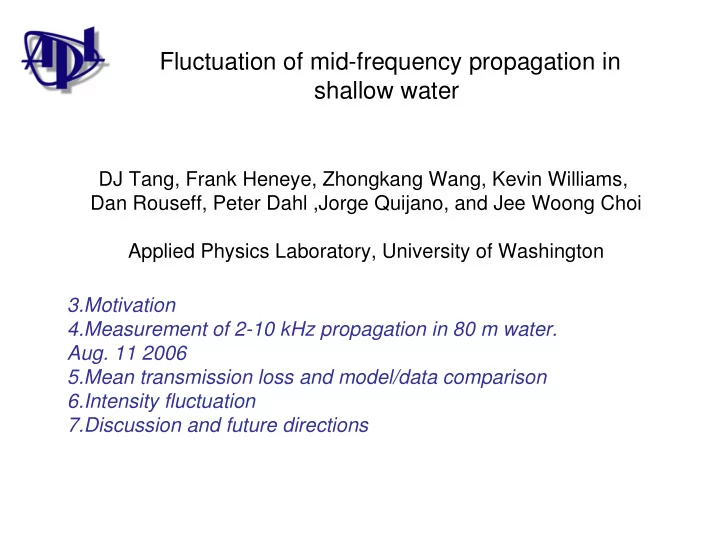

Fluctuation of mid-frequency propagation in shallow water DJ Tang, Frank Heneye, Zhongkang Wang, Kevin Williams, Dan Rouseff, Peter Dahl ,Jorge Quijano, and Jee Woong Choi Applied Physics Laboratory, University of Washington OUTLINE: 3.Motivation 4.Measurement of 2-10 kHz propagation in 80 m water. Aug. 11 2006 5.Mean transmission loss and model/data comparison 6.Intensity fluctuation 7.Discussion and future directions
Motivation • Intensity fluctuation creates uncertainty affecting sonar performance in shallow water There is little shallow water mid-frequency (1-10 kHz) data suitable for • addressing fluctuations in acoustic propagation and accompanied by detailed environmental measurements • Past work: Ewart and Reynolds , (1984): Deep water, scintillation Duda, Lynch, Newhall, Wu, and. Chiu , (2004): SCS, 400 Hz Fredricks, Colosi, Lynch, Gawarkiewicz, and Chiu (2005): low- frequency, New England shelf Pasewark, Wolf, Orr, and Lynch (2002): low-frequency, New England shelf Simmen, Flatte, DeFerrari, Nguyen, and Williams (1999): Caustics DeFerrari, Williams, and Nguyen (2003): caustics Lyons, Bradley, Culver, and Becker (2006): not yet published • Goal: Understand intensity fluctuations with measured environments
Measurement: 9 stations on 80m isobath, 1, 2, ..,9 km stations, 100 pings at each. 2-10 kHz 20 ms-long FM sweep MPL/UVic and DRDC took measurements along same track on different days
Measurement Antenna, battery pack & RF modem Surface decoupling MORAY BASS-2 80 m 2 m, 4 element VLA MF source at 2 depths 2-10 kHz range 30 m depth 1-9 km Acoustic release DAHL
Measurement: 2D SSP measured by a towed CTD Chain at 1 km range station ( UW02, 9:20 ). • Sound channel, • No large internal waves, • Some spice observed • Complex range-dependent structure
Sound Speed Profile and range-independent ray tracing to 2 km: Propagation is dominated by trapped energy in the channel
Pulse Compressed Acoustic Data Transmitted pulse R = 1 km Travel Time (ms)
TL – model/data comparison Environmental Input: The mean field is modeled by spreading loss + seawater absorption with random phase modes. The mode cutoff is assumed to be at the bottom critical angle. Modes computed by: Water column: measured SSP without fluctuations Bottom: homogeneous half-space (from SAMS UW03/2 8:20 ):
However, TL fluctuates as much as 12 dB Transmission Loss(2kHz,Source at 30m,Receiver at 25m) 70 65 Transmission Loss(dB) 60 55 50 45 1 2 3 4 5 6 7 8 9 Range(km)
Ping-to-ping fluctuation at representative ranges Broadband deep fades observed
Intensity fluctuations -- scintillation index Theories address single-frequency scintillation index With a broadband measurement, the scintillation index generally is smaller. How narrow does the bandwidth have to be so that the single-frequency SI is estimated? Look at cross-frequency intensity correlation to answer this Question.
Inter frequency coherence(ch=1) 10 9 8 7 6 5 4 3 2 1 0 -1 -8000 -6000 -4000 -2000 0 2000 4000 6000 8000 Frequency(Hz)
Cumulative Distribution Function (CDF): 10 Hz bandwidth. CDF’s averaged over 1 kHz band. CDF is exponential (unexpected): Zero intensity most probable (deep fades) SI = 1
Comparison of PDF’s 1 0.8 0.6 PDF 0.4 0.2 0 0.5 1 1.5 2 2.5 3 Normalized Intensity
Discussion 3. Mean TL is well described by a simple incoherent mode model 5. Fluctuations due to water column variability 7. Narrow cross frequency correlation (100 Hz) for most range-frequency combinations, but much greater than the 10 Hz band used for intensity distribution ⇒ nearly saturated. ≈ 9. Scintillation index 1 and deep fades 11. Fluctuation and deep fades have implications to sonar signal processing and bottom inversions
Future Directions − modeling observed strong fluctuations 3. Develop a model, such as the moments equations, to quantitatively compare with data (hard) 5. Test the validity of assumptions made in transport theory (Dozier and Tappert) then apply to data comparison 7. Numerical simulations (PE) and comparison with data
Future Directions − oceanography 3. Internal wave spectrum to be confirmed 5. Is such a spectrum sufficient on time and spatial scales where acoustic predictions are needed 7. Is spice important. If so, how to deal with it
Future Directions − acoustic measurement 3. Need fixed source and receivers to measure the mean coherent field over time and space
Recommend
More recommend